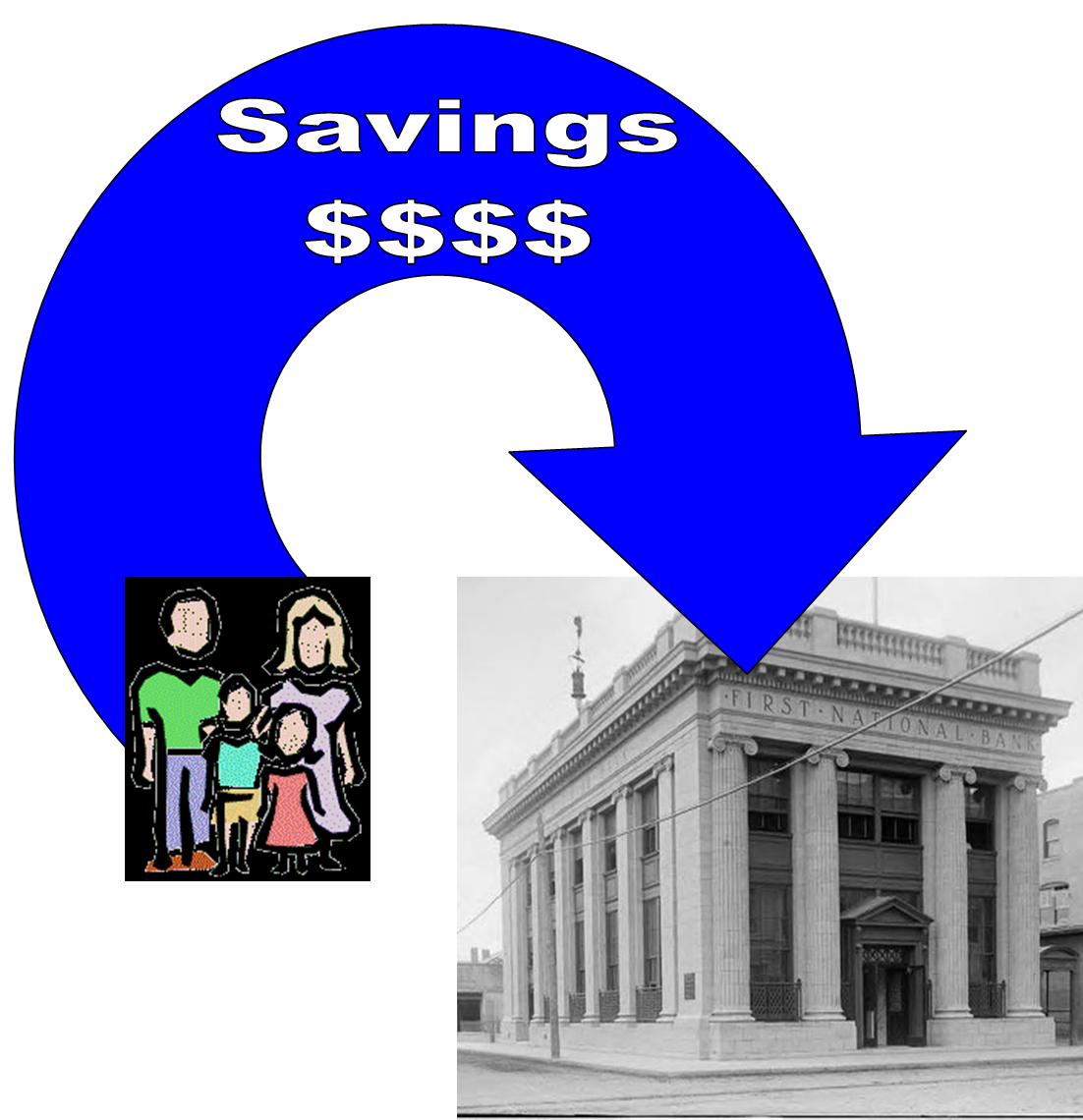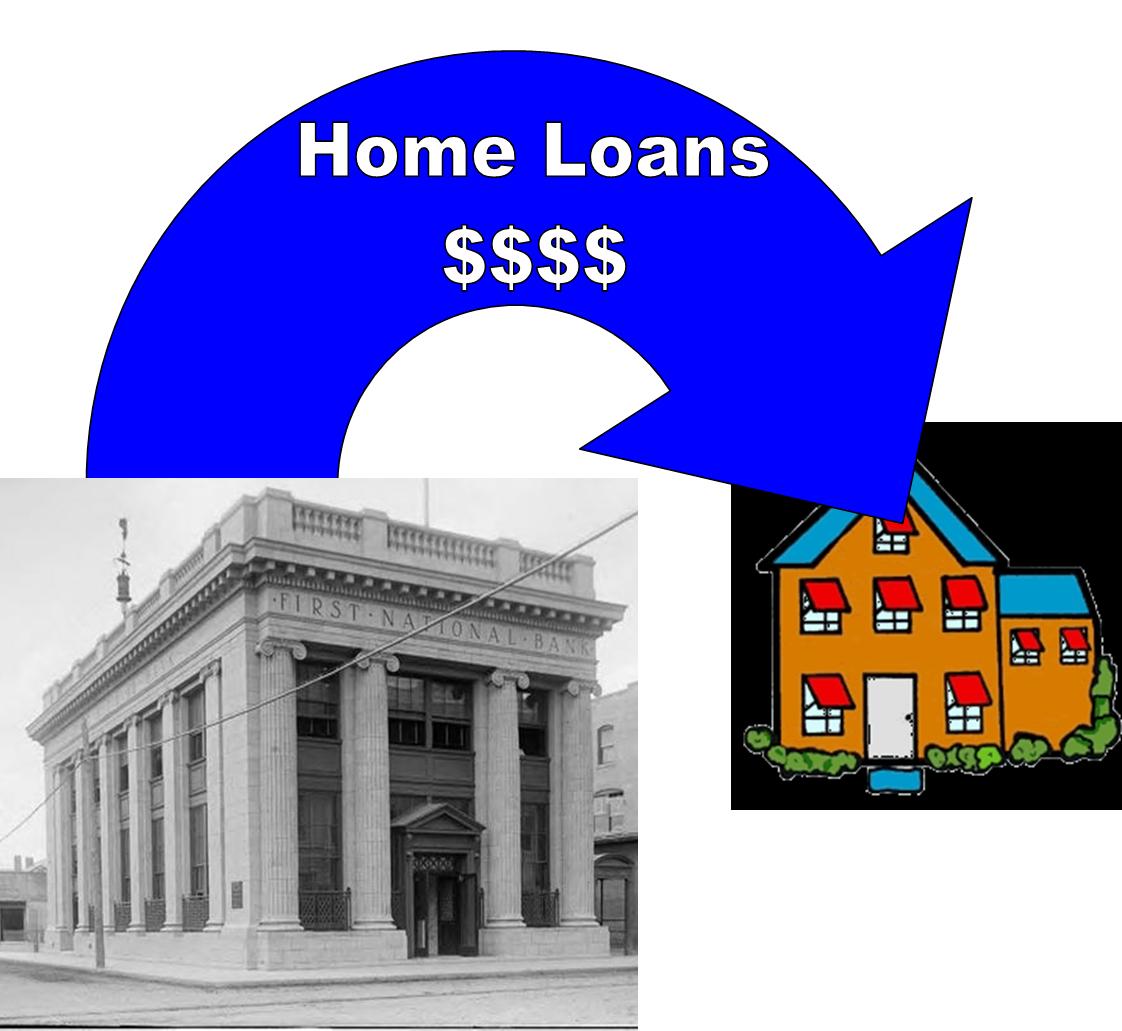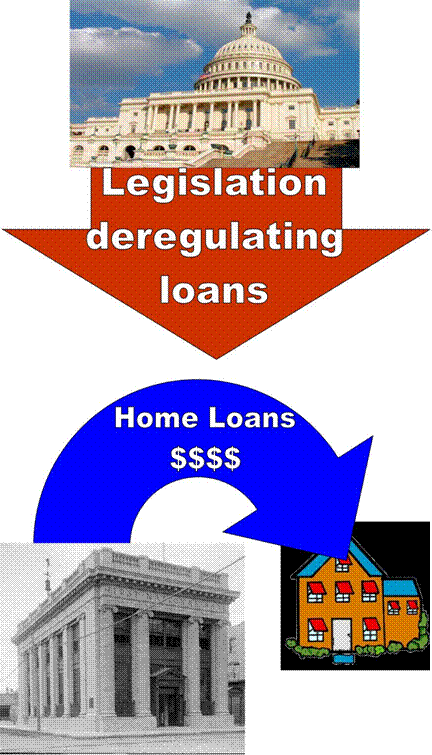Hi. We had a stock market crash. On October 9, 2007, the Dow Jones industrial average reached a record 14,164. Exactly one year later, October 9, 2008, the Dow closed at 8,579. The United States stock market lost 39.4%. What happened? Why is the economy in such bad condition that the U.S. Congress just voted for and the president signed into law a 700 billion dollar banking bail-out legislation?
You’ve heard about Republican deregulation, about Freddie and Fannie, and you’ve heard about failed financial policies. Everything seems so complicated. Our national leaders said we had to have this bail-out or things would become even worse than what they are. What happened and whose fault was it? Did we really need this expensive bill to be passed? Let me explain. Understanding this should impact your vote in this presidential election.
People Put Their Money, Their Savings, Into Banks
Dads and moms have jobs and they make money. They put their money into banks. When they put their money into a savings account, they are able to earn a little bit of interest on their money from the bank. This interest a bank will pay on a savings account is usually around 3%. Banks earn money by investing the money that people deposit in their savings accounts.
Banks Give People Loans to Buy a House—These Loans Are Called Mortgages
Banks can earn money by making home loans. They receive more interest on the home loan than the interest money people receive for their savings account. In order for people to get a home loan, they must qualify to have that loan. Those qualifications once were much more strict. These banks knew they were investing other people’s money, so they were very careful who they would loan it to. The old standard for getting a loan was having at least a 700+ credit score, 20% down payment on the loan, five years on a job, two months of payments in the bank, and no bankruptcy in the last eight years. When those standards were enforced, people rarely defaulted on their loan and lost their homes to foreclosure.
loan it to. The old standard for getting a loan was having at least a 700+ credit score, 20% down payment on the loan, five years on a job, two months of payments in the bank, and no bankruptcy in the last eight years. When those standards were enforced, people rarely defaulted on their loan and lost their homes to foreclosure.
Banks make money by the people paying back their loans at a higher interest than they are giving back to customers in savings interest. Banks also loan money to businesses in the form of business loans. The way that many small businesses operate is that they use these loans to buy inventory, paper for billing customers, and for paying their employees. They pay back the loans with the money make from their business. Everything in the United States economy was moving along fine with the kind of arrangement that I’ve described so far. But then something happened.
The United States Government Changed the Rules for Home Loans
Something did happen and what happened first was President Jimmy Carter in 1977. Banks would not give loans to people in certain neighborhoods—it wasn’t very safe banking practice to do so. President Carter changed this by signing the Community Reinvestment Act (CRA). This law made banks give loans to people who lived in those bad loan areas. The idea, of course, was that if more people owned homes in those areas, they would do a better job of taking care of the neighborhood. CRA encouraged home loans through  two government sponsored enterprises: one was The Federal National Mortgage Association (Fannie Mae) and the other was The Federal Home Loan Mortgage Corporation (Freddie Mac). With this new law, to go unpunished by the federal gov
two government sponsored enterprises: one was The Federal National Mortgage Association (Fannie Mae) and the other was The Federal Home Loan Mortgage Corporation (Freddie Mac). With this new law, to go unpunished by the federal gov ernment, banks had to find buyers who could qualify for loans under the old, reliable standards. They often could not find any so out of the lack of qualified buyers hatched the concept of the sub-prime mortgage.
ernment, banks had to find buyers who could qualify for loans under the old, reliable standards. They often could not find any so out of the lack of qualified buyers hatched the concept of the sub-prime mortgage.
CRA also created hundreds of unregulated housing “agencies,” who would lobby banks for more money for their agencies. If they couldn’t get the money, these agencies would cause great difficulties for banks with nasty lawsuits. The Reverend Al Sharpton was involved with these. One of these agencies, the Association of Community Organizations for Reform Now (ACORN) bragged that because of their influence, over one trillion dollars worth of these CRA sub-prime mortgages were written. Now Senator Barack Obama was a community organizer heavily involved in ACORN.
We’re not done yet. In 1980 President Jimmy Carter signed The Deregulation and Monetary Control Act. In 1982 President Ronald Reagan signed The Alternative Mortgage Transactions Parity Act. These two laws created some modern mortage products with which we have now all become familiar: adjustable rate mortgages (ARM), balloon payment mortgages, interest only mortgages, etc. In 1986 the IRS tax code was changed to give a deduction for only the interest on a home loan. Financial advisors started encouraging customers to pay off mortgage debt only and to pay off other forms of debt with the equity in their homes. In 1993 President Bill Clinton made changes to the CRA that made it even more difficult for banks to deny loans to under qualified and gave banks points for giving out the more exotic loans.
Home loans became a major business. Many made incredible amounts of money as loan brokers. Amazing numbers of loans and bad ones, deceptive ones, were given to unqualified buyers. These mortgage brokers were just swimming in the waters created by the deregulation in the industry, that was designed by Democrats for the purpose of social architecture in poor neighborhoods.
Mainly Under Qualified Home Owners Defaulted on Millions of Home Loans
After a certain period of time, the creative loans given to under qualified buyers began to balloon and adjust to a higher rate, pricing the owners out of their own homes. The defaults on loans started as a trickle and built to a giant river of foreclosures. People were not paying back their loans to the banks. The banks were losing money.
Many of the banks were tied up into investment firms and investment organizations were strapped into banks. Many businesses needed banks for loans to operate. Corporations began to suffer the effects and the stock market began to drop. Banks and investment companies folded. Remember those people who had put their money in the bank? They were afraid, so in many cases, they ran to the banks to take out th eir money. People foreclosed on their houses and stopped making payments to the banks on their mortgages. Then others took their money from the banks. Many banks collapsed. The housing mortgage bubble popped and down came the U. S. economy with it.
eir money. People foreclosed on their houses and stopped making payments to the banks on their mortgages. Then others took their money from the banks. Many banks collapsed. The housing mortgage bubble popped and down came the U. S. economy with it.
Why Didn’t Someone Warn Us About This Happening?
1999 was the first wave of sub-prime company busts. We didn’t hear much about it in 2000 because that would not reflect well on Vice-President Gore’s presidential run. Some warned about it. Several Republicans in the Senate gave warning, including Senator John McCain in 2005. Reforms of the mortgage industry were championed in the Senate by Senator John Sununu, who is presently losing his Senatorial race in New Hampshire to liberal Democrat and former Governor Jeanne Shaheen ironically in part because of the financial crisis. In 2003, Franklin Raines, CEO of Fannie Mae, said that they would not put effort into verifying immigration status of those applying for home loans. Yes, illegal immigrants contributed to the bank and mortgage crisis we’re now in. There were many in the Senate who were given giant campaign contributions by Fannie Mae. Some of them were those in charge of government oversight of the home loan organizations. As late as July of this year, Democratic Senator Christopher Dodd, chair of the Senate Banking Committee, called Fannie and Freddie, “fundamentally strong.” In 2007, the sub prime mortgages had begun to crumble again, but a number of economic factors would not allow anything to stop the destruction that has taken place.
Why the Bail-Out?
As I understand it, this financial collapse has resulted in a lack of credit available for doing business. Almost everything operates on credit now. If businesses don’t have credit, they will lay off employees. The unemployment rate could double. If it doubles, even more people won’t pay their mortgages placing more stress on banks. More credit will also allow the big mortgage lenders to sell some of their defaulted mortgages to other institutions. Less foreclosures will mean stabilization of housing prices which will save the equity of homeowners who did not default on their loan. Even if they did pay their mortgage, so many others didn’t that their home price has plummeted.
That’s my explanation. I won’t say that it will work or that it is right.
So Who Is to Blame?
It is easy to see who should be blamed for the bank crisis. You just read how it happened. It isn’t Wall Street, although corporations are an easy target in an environment of class warfare like we see in the election season. It isn’t even the banks, who faced great pressure to go along with the new regulations. Who is to blame, more than anyone, are our elected representatives. That would make use to blame too, because we elected them. However, a lot of what they do is so that they will be more and more popular in order to win elections.
Our government changed the laws that would protect the mortgage industry and banks. It was almost entirely Democrats who did it in order to curry the favor of their special interests. They were involved for 30 years in forcing banks to give loans to people too poor or untrustworthy to pay them back. Now they’re successful at putting the blame on everyone else.
The Bank Crisis for Dummies would like to thank my friend Mike Marshall, a long time banker in Michigan, for sending out an explanation of the bank crisis. It helped greatly with the writing of this post.
Nice article 🙂 I think most of the world’s citizens have no idea what the hell is going on. Most of the business professionals and politicians know WHAT is going on, but they will never be sure WHY. I believe when you ask 10 people in five years, you will get 15 answers WHY it happened. Democrats – hm, ok, they eased the mortgage rules, but what about FED and its crazy interest rate around the year 2002? What about banks going into risky deals? What about situation today, when hundreds of billions pieces of paper are pushed into economy without desired effect? And finally, what about the ordinary citizens, who didn’t take risk into consideration and purchased properties out of their living standard?
The answer is not so easy…
Take care
Julie
Julie,
There are other factors for sure. Yes, the fed lowered the interest rates and kept them there. We’ve got greedy CEOs of mortgage companies that took the ball and ran with it. Yes, yes, and yes. But none of it would have happened if there wasn’t this loosening of the regulations for the sole purpose of getting the unqualified to qualify. Why? To get their votes. Ooops, I mean to help them!
I wanted you to know too that we only use “hell” here as a noun, not as an adjective. Nothing is like hell, except hell.
http://ifbkjv.blogspot.com/ Oh, I really hope you will join our blog directory! Great article! Let me know if you want to be a contributing author, too. http://ifbkjv.blogspot.com/
nice article, but its easy to read your bias, even for an illiterate person like me.
I'm an econ teacher. Don't rely on this biased representation of history for your opinion on the issues surrounding the collapse. A more unbiased analysis would lay blame at both parties and Wall Street and the Fed. Predatory lending is not even mentioned above. The history of housing loan discrimination (a legitimate economic issue and social concern) is left out of the dialogue. Also, if poor people were getting fixed-rate loans without balloon payments or many of the other predatory devices devised by Republicans and Democrats alike, our housing bubble wouldn't have been so big. Many of us made money off of the housing bubble and didn't adequately keep the institutions fueling the process in check.
"….With this new law, to go unpunished by the federal government, banks had to find buyers who could qualify for loans under the old, reliable standards. They often could not find any so out of the lack of qualified buyers hatched the concept of the sub-prime mortgage"….
unadalterated nonsense, Sup prime was not "invented because of Jimmy Carter" and CRA. Further sub prmie wasa function of the shadow banking system (read Wall Street). Finally please read CRA, it says right in it the banks do not have to make "bad loans" and also CRA has three components.
Guys like you give blogs a bad name as you print utter drivel as fact.
kind of lazy.
For whoever comes along now and reads this, written now a few years ago—I never used the words "invented because of Jimmy Carter" so those words shouldn't be in quotes. I said that subprime came along later because they couldn't find qualified buyers and they needed to do so.
Many agree with my assessment, but consider these:
http://www.businessinsider.com/the-cra-debate-a-users-guide-2009-6
http://www.lewrockwell.com/dilorenzo/dilorenzo125.html
Predatory loans came, yes, but they came with the encouragement of the federal govt.
Read especially the first link I gave above, which has many links documenting.
Great article. I'm pretty ignorant when it comes to finance, but i've always been interested in this topic. Many of the articles on this subject contain so many finance terms and theories that i spend most of my time researching them just to understand the main article. I'm embarassed to admit that. Other articles i've read on this topic mention credit default swaps as another variable that helped create this scenario. I understand what a CDS is, but i was wondering if you could perhaps elaborate a little more on the role cds's might have played.
It is fact that HUD in partnership with the Justice Dept. passed "incentives" to strong-arm banks to give these loans to folks who normally would be a liability for any sane loaning practice. Banks do not want to take "obviously foolish risks"! The "incentives" where threats of the justice department coming down on any bank that did not comply. There was an attempt in 2005 by the Bush Admin. and twenty Republicans in the House and Senate to pass the Federal Housing Enterprise Regulatory Reform Act, all to re-regulate this dangerous practice, because the writing was on the wall…it never passed as it was shot down by the Democrat-run congress. Yes, I am biased…so are you on the left…big deal.
The ways of production trough the coporations change hands in the enod of 2008, If you know a little bit of hisory, you would know that this kind of programed crisis happened for the means of production to change hands, happened with the rotschilds in England, happened in 1929. If you have stocks and check EVERY stock in that moment they all went down in average a 60 to 70% ALL OF THEM. Then the architects of this scam bought the whole market for penies of the dollar, and then rescue themselves. The government change the rules because the elite ordered it, get the whole world in the scam by selling them bad credits, declared themselves broke, force the government to bail them out, and so… the story is already there. Forget about dmocrats or republicans, they all work for the same interests. Check now the prices of the stock market, is still not the same of the previous price but is gong soon with this bai outs provoking the inflation we would never have dreamed about in the whole world, make the chinese credit have less value and anyway flooding the world with promises of credit. I´m sorry if my exlanation was not clear or I make mistaked in the redaction of my opinion, I´m not native english speaker, I´m Mexican.